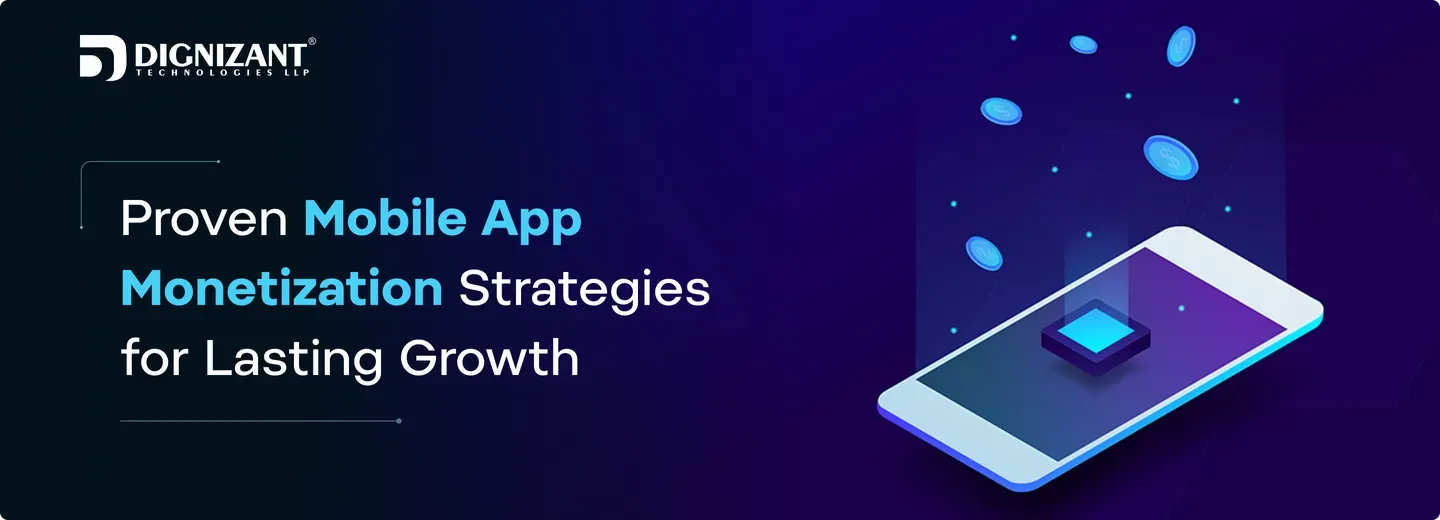Proven Mobile App Monetization Strategies for Lasting Growth

Contributor
Palash Pandya
Uploaded
30 October, 2025
Read Time
6 Minutes
In today’s rapidly moving digital economy, creating a mobile app is only the start. The hard part is turning that app into a sustainable revenue source. With millions of competing apps in the iOS and Android app stores, it takes more than simple downloads for success. You want an obvious plan for monetization that is both profitable and does not piss off your users.
Whether you're building a gaming app, a fintech provider, or productivity software, various monetization models can be merged in order to achieve sustainable growth. In this post, we’ll discuss the best mobile app monetization strategies to earn every time and keep your users engaged, informed and trust your product.
Understanding Mobile App Monetization
Mobile app monetization is really just the act of making money through your app’s users. This could involve direct user fees, in-app purchases or use of advertising and business partnerships. The proper approach is going to be based on your app’s audience, business model, and long-term objectives.
The proper approach is going to be based on your app’s audience, business model, and long-term objectives. Before getting into tactics, you need to grasp this golden rule: Monetization is supposed to enhance user experience, not interfere with it. The more value filled, the better your monetization will come automatically.
1. Freemium Model: The Gateway to Engagement
The freemium model is still one of the best and traditional mobile app monetization strategies. In such a model, users can download and play the app for free in this model, but if you want to have premium features or content you need to pay for an upgrade.
Why it works:
The freemium approach builds trust. Users can interact without making a commitment. After they recognize that value, they’re more likely to spring for optional upgrades like an ad-free experience, advanced analytics or exclusive features.
Example: Spotify offers free streaming with ads, but pays artists very little and takes a cut for ad-free interface and offline downloads. The free to paid transition is so smooth because the users already derive value before upgrading.
Best practices:
- Provide distinction in value between free and premium levels.
- Cripple the free experience but limit premium features.
- Prompt users to upgrade with relevant prompts and offers.
2. In-App Advertising: Monetize Without Direct Payments
Advertising is still a key mobile app monetization strategies, particularly for apps with huge numbers of users. Here are the ad formats available:
Banner Ads: A tiny ad on the top or bottom of the app screen.
Interstitial Ads: Interstitials are full-page ads that show during natural breaks, for example between game levels.
Rewarded Ads: Player chooses to view an ad in return for incentives in the app.
Native Ads: Integrate seamlessly with your app’s content for a less disruptive experience.
Why it works:
Apps can earn steady income through on-app advertising at no cost to users. Rewarded video ads, specifically, are successful in gaming and entertainment apps because they give users control and take action to earn a reward.
Example: Mobile-phone games offer people to watch short ads in exchange for additional lives or boosters. This is a balance between user satisfaction and sustainable ad revenue.
Best practices:
- Don't drown your users in too many ads.
- Always start with the highest CPM(cost per mille) ad networks that have quality targeting.
- Try a few ad placements to avoid inconvenience.
3. In-App Purchases (IAP): Creating a Micro-Economy
In-app purchases are further used by a user to purchase digital goods, features or virtual currencies available through the application. This approach succeeds in gaming, lifestyle and social apps where engagement is driven by personalization or progression.
Why it works:
IAP creates an internal ecosystem where users are investing in your app’s world. Whether it’s a new outfit for a game avatar or unlocking premium filters on a photo editor, these tiny transactions add up to big bucks.
Example: Clash of Clans makes billions on IAPs for gems, resources and upgrades without having upfront charge.
Best practices:
- Deliver both consumable (one time use) and non-consumable (permanent) items.
- Execute those rewards in ways that make the game better.
- Leverage data to optimize pricing and offers.
4. Subscription Model: Ensuring Recurring Revenue
Subscription based services offer predictable, long term revenue by charging a customer for the benefits of premium content or features over time (monthly, quarterly and annual plans).
Why it works:
This model established more sustainable revenue sources since it promotes continuous use by users. This is great for productivity apps, news, streaming services and fitness.
Example: Netflix and Duolingo are both subscription businesses. There is ongoing value to the product which gives a reason for customers to pay month after month.
Best practices:
- Offer various options (monthly, yearly, family, student).
- Provide a free trial to remove friction for new subscribers.
- Constantly release or add new content to justify the subscription.
5. Affiliate Marketing and Partnerships
With Affiliate marketing, you can make money by promoting third party products or services in your apps. You make a cut of the sale when users buy through your referral link.
Why it works:
This is a very intrusive model if you do it right, because ideally they never see an A/B option again. Through cooperation with brands, value is provided and user traffic monetized.
Example: Fitness app suggesting protein supplements or workout clothing via affiliate links. It fits naturally into the user’s interest and brings utility.
Best practices:
- Make sure affiliate products are related to your app’s theme and user intentions.
- Be transparent about affiliate partnerships.
- Observe results with analytics to enhance placements.
6. Sponsorship and Brand Collaborations
If you have a large user base, or one from a niche then there are app-brand sponsorship deals to be found as well. Brands pay you to showcase their content, products or services in your app.
Why it works:
Unlike traditional advertising, sponsorships create credibility and are mutually beneficial. As a brand gets a presentation to your followers, you get paid directly.
Example: A meditation app with sponsored sessions from wellness brands or mindful getaways.
Best practices:
- Select sponsors relevant to your audience’s lifestyle and values.
- Maintaining authenticity forced promotions can backfire.
- Natively blend branded content into your app flow.
Building a Sustainable Mobile app Monetization Strategies
Sustained growth happens when revenue creation and long-term trust are balanced out. Here are guiding principles of a sustainable strategy:
- Focus On User Experience: Monetization should be an add on to engagement, not the other way around.
- Data-Driven Decisions: Track metrics like ARPU, retention rate, and conversion funnels.
- Continuous Testing: Check pricing, ad formats and features to see what combinations work best.
- Iterative Testing: Examine various pricing, ad formats and functions together for best Integrations.
Conclusion
Monetization isn’t about wringing money from users, it's about providing enough value that they actually want to spend money on what you’re creating. The best apps, frequently with the support of a professional mobile app development company, are those which build monetization into their DNA as opposed to tacking it on at the end.
In a field as competitive as today’s mobile app market, if you aren’t monetizing correctly then it could mean the difference between short term financial success and long-term failure. The true magic is to mix creativity with analytics, that every dollar you pocket grows the business, not only enhances happiness and loyalty of users over time.
Latest Articles

Build secure, intelligent financial platforms with advanced fintech web development designed for speed, compliance and exceptional user experience.

Unlock mobile success by selecting the Best Tech Stack that boosts reliability, enhances UX, and supports long-term app evolution.

Boost web performance and loading speed through expert Performance Optimization in Python techniques for faster, scalable, and efficient applications.
FAQs
Ready to Take Your Business to the Next Level?
Unlock new opportunities with expert solutions designed to elevate your brand. From strategy to execution, we empower your business with the tools, technology and talent it needs to thrive in today’s digital world.


